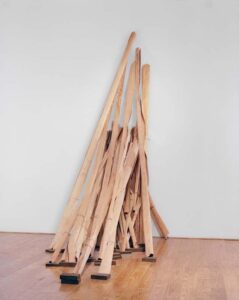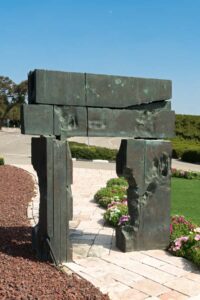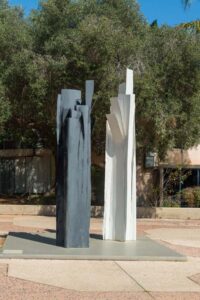

From the artist notebook
Images of my childhood and my adolescence consisted mostly of desert scenes, the Pyramids, the Sphinx, and monumental sculptures.
Our outings were often directed towards Guiza, and beyond in the desert. A one Piaster ride in the Tramway would bring us right to the Pyramids. We would walk up the hill, and behold find ourselves facing these magnificent overwhelming structures. A little further, the Sphinx, sat, extraordinary, majestic and mysterious.
Behind was the desert, endless sands in a variation of ochre, white and pale yellows. There one felt at peace and safe. There was a sense of timelessness. The desert was engulfing, vast and strong. One felt in communion with the surrounding, at peace and unafraid. What seemed endless space was welcoming and friendly.
There were other images, that of Cairo, a bustling city, with its exotic flavor, the Nile, its bridges, the Jasmines and the Bougainvilleas that awaited the evening breeze. The incomparable Proustan flavor of life along the Nile has been engraved in the minds of those who lived it.
Images of the populated areas where women dressed in the native style. Black melayas would shroud their bodies, leaving only a suspicion of what their shape was really like. Under the shroud they carried their hopes, their pain, their secrets.
Cairo enchanted many, the Jasmines and the Bougainvilleas however did not make up for the poverty and squalor. Misery was all around, misery was normal.
Until I left Egypt at age 18, I had not been exposed to Modern Art.
Other than the antiquities that boggled the mind and left a deep mark, there was the yellow and white reflection of the beating sun that created deep and dark shadows. The arabesques and geometric decorations in wood, metal,
and in stone, also rugs of restrained and wonderful patterns, made up
another layer of visual experience. There was more. The domes and minarets, the shape of the earthenware jugs with their polished brass covers on which surface we could see our distorted reflections. They sat on windowsills offering cool water to the thirsty.
Memory
In the hope of prolonging memory, and giving meaning to our existence we stretch the image. We try to preserve.
Before the fog of time blurs the mind and erases ruthlessly what for a moment in time appeared relevant and important, we endeavor to record.
Whether we reconstruct, transmit information, create beauty or protest our condition we strive for a measure of continuity even though temporary.
*****
Although permanence is not a prerequisite and adjusting to new realities is a challenge, we still endeavor to preserve the memories of our experiences, of our passage however insignificant.
*****
The theme of rebuilding has been a central focus in my work. The theme of continuity is of vital essence to me.
My aim is to transmit preservation and continuity.
*****
Art is where we find shelter when we no longer comprehend the world around us. But it is that blessed thing that brings us sublime moments and total communion.
*****
We define personal evolution as continuously recreating ourselves.
We wonder at our capacity for rebuilding.
*****
I am moved by the humanity of man, by his capacity for rebuilding each day his burnt out world, by his being in turn fierce and frail, powerful and helpless.
Forest
1989 – Ramat Gan Museum
This work in wood veneer is meant to endow a different meaning to space.
One that is isolated, contemplative and private.
I would like to believe that it demands of one to pause, to ponder in a personal and private shrine.
The forest is for me a place where we sit and listen to our inner voice. An oasis, perhaps, where we the travelers catch our breath on our continuous voyage. This is a place of temporary serenity—a pause in our journey.
These treelike structures come into being through the actual peeling of tree trunk. To me the process is a sort of back ward progression in the chronicles of the tree- In a way the tree starts in the forest, it is cut made into veneers and returns to be a tree sculpture.

Scrolls and Manuscripts
Julie M Gallery, 1988
This show represents an orderly reconstruction, a rebuilding of layer upon layer of sustained rhythm, of well rooted columns reaching high, sometimes
marked, sometimes burnt but carefully selected to build upon.
Manuscripts, wood works that are scarred and now tranquil.
Continuity II
2005, Acrylic on canvas, foamcore, and wood, 187.96 x 71.12
This show is made of recycled material, mostly drawn from the previous exhibition, “Passage,” which included Bundels and Tents.
These are undone, reconstructed and given new meaning and new appearance. The exhibit is about rehabilitating the material. I deal with gathering remnants that I can build on, salvage before they crumble, in order to keep them from collapse.
Bundles of folded cloth are no longer tied with ropes. Tents no longer serve for human habitation. Like shadows, their meanings shift. They are the survivors of other objects, of objects lost, destroyed. They are part of an endless chain of “begats.”

Cosmos
“Cosmos” series, 1999-2000
Metallic paint, acid on aluminum, wood, each 22.23 x 15.24, These are intimate works of small aluminum or brass plates. Paint is not used but diluted acids causes oxidation.One needs to work very fast as the material is alive and keeps changing.In this process it is important to control the oxidation time.
Leaning
1989, Veneer, rope, steel weights, h. 320
The wall is purposeful and the sculpture will not hold without the wall.
The metal blocks prevent it from sliding. The supports become integrated into the sculpture, and without them the sculpture collapses.

Books
Engraved with words, they are the carrier of history. Books have their own magic. Words, those little graphic symbols linked and combined transmit the thought of man.
They are the witness of generations, they are the footprint of man.
Books reflect what we are- they are the mirror of the society in which we live.
To celebrate books is to celebrate man, for it is he that caused the magic to happen.
Gates
1975, Bronze cast, 220 x 197 x 30/66, Collection Ben Gurion Airport, Lod
Suggest passage – beginning, middle, the end, which in turn is a new beginning.

Passage
Passage, 2000, Acrylic on canvas, wood, installation containing 14 figures, h. 128-236
Perhaps I was trying to convey the longing to record something very precious and fragile and about to vanish.
This exhibition represents a body of work of the nineties- glimpses of Egypt where I was born, the temporary condition and silent archives.
These works are for me experience over a continuum of time, of weight that we must carry, of our capacity to adapt and move on.
It is sorting, putting some kind of an order in preserving.
Ascent
1985, Aluminum painted, h. 365.76
Collection Weitzman Institute of Science, Rehovot
This work represents the humanity of man and his ascent in the course of civilization. Columns, because they are the basic support of structures, the essence, the fundamental pillars on which we build.
The black and white are the dialectic forces that interplay.
White being the purity, black the dark forces that are within us.
Science upholds our progress; the humanity of man sustains our values.
